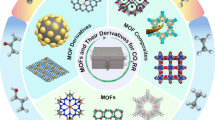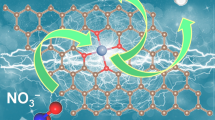Abstract
Developing heteroatom-doped carbon catalysts toward oxygen reduction reaction (ORR) to replace platinum (Pt)-based catalysts is a promising strategy. Herein, nitrogen (N), sulfur (S) dual-doped porous carbons (NS@C-x-y) were prepared via a one-step carbonization of the mixture of acid treatment coal tar pitch (CTP) and MgCl2·6H2O, through in situ self-generating MgO template route. N and S were successfully introduced into the carbon framework of CTP by mixed acid treatment, leading to N, S co-doping especially pyridinic-N, graphitic-N, and C-S-C as ORR active sites. Benefiting from the fluffy lump graphitic structure, large surface areas, and synergistic effect between N and S electrocatalytic sites, the resulting samples demonstrate superior ORR performances with the highest diffusion-limited current density of 5.97 mA cm−2 and half-wave potential of 0.82 V (vs. RHE), long-term stability, and excellent methanol tolerance in alkaline medium, which are competitive with Pt/C catalyst.






Similar content being viewed by others
References
Tang J, Liu J, Torad NL, Kimura T, Yamauchi Y (2014) Tailored design of functional nanoporous carbon materials toward fuel cell applications. Nano Today 9(3):305–323
Gu P, Zheng M, Zhao Q, Xiao X, Xue H, Pang H (2017) Rechargeable zinc–air batteries: a promising way to green energy. J Mater Chem A 5:7651–7666
Devi KSS, Jain A, Huang S-T, Kumar AS (2019) Metal and heteroatoms-free carbon soot obtained from atmospheric combustion of naphthalene for sensitive dissolved oxygen reduction reaction and sensing in neutral media. Electrochim Acta 296:407–417
Guo D, Shibuya R, Akiba C, Saji S, Kondo T, Nakamura J (2016) Active sites of nitrogen-doped carbon materials for oxygen reduction reaction clarified using model catalysts. Science 351(6271):361–365
Yu H, Shang L, Bian T, Shi R, Waterhouse GIN, Zhao Y, Zhou C, Wu L-Z, Tung C-H, Zhang T (2016) Nitrogen-doped porous carbon nanosheets templated from g-C3N4 as metal-free electrocatalysts for efficient oxygen reduction reaction. Adv Mater 28(25):5080–5086
Shen W, Fan W (2013) Nitrogen-containing porous carbons: synthesis and application. J Mater Chem A 1(4):999–1013
Díaz-Duran AK, Roncaroli F (2017) MOF derived mesoporous nitrogen doped carbons with high activity towards oxygen reduction. Electrochim Acta 251:638–650
Ma X-X, He X-Q (2018) Achieving superior performance for oxygen electrode catalyst by the assistance of NaCl to construct cobalt sulfide on nitrogen and sulfur dual-doped graphene. Int J Hydrog Energy 43(29):13256–13265
Roncaroli F, Molin ESD, Viva FA, Bruno MM, Halac EB (2015) Cobalt and iron complexes with N-heterocyclic ligands as pyrolysis precursors for oxygen reduction catalysts. Electrochim Acta 174:66–77
Liu F, Niu F, Chen T, Han J, Liu Z, Yang W, Xu Y, Liu J (2018) One-step electrochemical strategy for in-situ synthesis of S,N-codoped graphene as metal-free catalyst for oxygen reduction reaction. Carbon 134:316–325
Chen K, Hao Y, Zhang M, Zhou D, Cao Y, Wang Y, Feng L (2017) Nitrogen, sulfur and phosphorus-codoped carbon with a tunable nanostructure as an efficient electrocatalyst for the oxygen reduction reaction. RSC Adv 7(10):5782–5789
Molina-García MA, Rees NV (2018) “Metal-free” electrocatalysis: quaternary-doped graphene and the alkaline oxygen reduction reaction. Appl Catal A 553:107–116
Li Q, Chen W, Xiao H, Gong Y, Li Z, Zheng L, Zheng X, Yan W, Cheong W-C, Shen R, Fu N, Gu L, Zhuang Z, Chen C, Wang D, Peng Q, Li J, Li Y (2018) Fe isolated single atoms on S, N codoped carbon by copolymer pyrolysis strategy for highly efficient oxygen reduction reaction. Adv Mater 30(25):1800588
Liang J, Jiao Y, Jaroniec M, Qiao SZ (2012) Sulfur and nitrogen dual-doped mesoporous graphene electrocatalyst for oxygen reduction with synergistically enhanced performance. Angew Chem Int Ed 51(46):11496–11500
Hu C, Yi Z, She W, Wang J, Xiao J, Wang S (2018) Urchin-like non-precious-metal bifunctional oxygen electrocatalysts: boosting the catalytic activity via the in-situ growth of heteroatom (N, S)-doped carbon nanotube on mesoporous cobalt sulfide/carbon spheres. J Colloid Interface Sci 524:465–474
Hua Y, Jiang T, Wang K, Wu M, Song S, Wang Y, Tsiakaras P (2016) Efficient Pt-free electrocatalyst for oxygen reduction reaction: highly ordered mesoporous N and S co-doped carbon with saccharin as single-source molecular precursor. Appl Catal B Environ 194:202–208
Gao S, Liu H, Geng K, Wei X (2015) Honeysuckles-derived porous nitrogen, sulfur, dual-doped carbon as high-performance metal-free oxygen electroreduction catalyst. Nano Energy 12:785–793
Yu D, Zhou L, Tang J, Li J, Hu J, Peng C, Liu H (2017) Nitrogen-doped porous carbon nanosheets derived from coal tar pitch as an efficient oxygen-reduction catalyst. Ind Eng Chem Res 56(31):8880–8887
Xu Z, Zhang D, Yuan Z, Chen W, Zhang T, Tian D, Deng H (2017) Physicochemical and adsorptive characteristics of activated carbons from waste polyester textiles utilizing MgO template method. Environ Sci Pollut Res 24(28):22602–22612
Yuan Z, Xu Z, Zhang D, Chen W, Zhang T, Huang Y, Gu L, Deng H, Tian D (2018) Box-Behnken design approach towards optimization of activated carbon synthesized by co-pyrolysis of waste polyester textiles and MgCl2. Appl Surf Sci 427:340–348
Zhang W, Huang Z-H, Cao G, Kang F, Yang Y (2012) A novel mesoporous carbon with straight tunnel-like pore structure for high rate electrochemical capacitors. J Power Sources 204:230–235
Shao J, Ma F, Wu G, Dai C, Geng W, Song S, Wan J (2017) In-situ MgO (CaCO3) templating coupled with KOH activation strategy for high yield preparation of various porous carbons as supercapacitor electrode materials. Chem Eng J 321:301–313
Xie K, Qin X, Wang X, Wang Y, Tao H, Wu Q, Yang L, Hu Z (2012) Carbon nanocages as supercapacitor electrode materials. Adv Mater 24(3):347–352
Zhao J, Lai H, Lyu Z, Jiang Y, Xie K, Wang X, Wu Q, Yang L, Jin Z, Ma Y, Liu J, Hu Z (2015) Hydrophilic hierarchical nitrogen-doped carbon nanocages for ultrahigh supercapacitive performance. Adv Mater 27(23):3541–3545
Inagaki M, Kato M, Morishita T, Morita K, Mizuuchi K (2007) Direct preparation of mesoporous carbon from a coal tar pitch. Carbon 45:1105–1136
Eisenberg D, Stroek W, Geels NJ, Sandu CS, Heller A, Yan N, Rothenberg G (2016) A simple synthesis of an N-doped carbon ORR catalyst: hierarchical micro/meso/macro porosity and graphitic shells. Chem Eur J 22(2):501–505
Funabashi H, Takeuchi S, Tsujimura S (2017) Hierarchical meso/macro-porous carbon fabricated from dual MgO templates for direct electron transfer enzymatic electrodes. Sci Rep 7(1):45147
Yang F, Fan X, Wang C, Yang W, Hou L, Xu X, Feng A, Dong S, Chen K, Wang Y, Li Y (2017) P-doped nanomesh graphene with high-surface-area as an efficient metal-free catalyst for aerobic oxidative coupling of amines. Carbon 121:443–451
Liu W-J, Jiang H, Tian K, Ding Y-W, Yu H-Q (2013) Mesoporous carbon stabilized MgO nanoparticles synthesized by pyrolysis of MgCl2 preloaded waste biomass for highly efficient CO2 capture. Environ Sci Technol 47(16):9397–9403
Pampel J, Mehmood A, Antonietti M, Fellinger T-P (2017) Ionothermal template transformations for preparation of tubular porous nitrogen doped carbons. Mater Horiz 4(3):493–501
Wang L, Wang J, Jia F, Wang C, Chen M (2013) Nanoporous carbon synthesised with coal tar pitch and its capacitive performance. J Mater Chem A 1(33):9498–9507
Wu H, Shi L, Lei J, Liu D, Qu D, Xie Z, Du X, Yang P, Hu X, Li J, Tang H (2016) Nitrogen and sulfur co-doped carbon with three-dimensional ordered macroporosity: an efficient metal-free oxygen reduction catalyst derived from ionic liquid. J Power Sources 323:90–96
Amiinu IS, Zhang J, Kou Z, Liu X, Asare OK, Zhou H, Cheng K, Zhang H, Mai L, Pan M, Mu S (2016) Self-organized 3D porous graphene dual-doped with biomass-sponsored nitrogen and sulfur for oxygen reduction and evolution. ACS Appl Mater Interfaces 8(43):29408–29418
Zhong H, Deng C, Qiu Y, Yao L, Zhang H (2014) Nitrogen-doped hierarchically porous carbon as efficient oxygen reduction electrocatalysts in acid electrolyte. J Mater Chem A 2(40):17047–17057
Liu T, Guo Y-F, Yan Y-M, Wang F, Deng C, Rooney D, Sun K-N (2016) CoO nanoparticles embedded in three-dimensional nitrogen/sulfur co-doped carbon nanofiber networks as a bifunctional catalyst for oxygen reduction/evolution reactions. Carbon 106:84–92
Zhai C, Sun M, Zhu M, Song S, Jiang S (2017) A new method to synthesize sulfur-doped graphene as effective metal-free electrocatalyst for oxygen reduction reaction. Appl Surf Sci 407:503–508
Nie Y, Li L, Wei Z (2015) Recent advancements in Pt and Pt-free catalysts for oxygen reduction reaction. Chem Soc Rev 44(8):2168–2201
Jin X, Xie Y, Huang J (2017) Highly effective dual transition metal macrocycle based electrocatalyst with macro−/mesoporous structures for oxygen reduction reaction. Catalysts 7(7):201
Kong A, Fan X, Chen A, Zhang H, Shan Y (2017) Mesoporous nitrogen-doped carbon microfibers derived from mg-biquinoline-dicarboxy compound for efficient oxygen electroreduction. J Solid State Chem 246:399–403
Ng W, Yang Y, Veen K, Rothenberg G, Yan N (2018) Enhancing the performance of 3D porous N-doped carbon in oxygen reduction reaction and supercapacitor via boosting the meso-macropore interconnectivity using the “exsolved” dual-template. Carbon 129:293–300
Wang C, Yang F, Qiu T, Cao Y, Zhong H, Yu C, Li R, Mao L, Li Y (2018) Preparation of an efficient Fe/N/C electrocatalyst and its application for oxygen reduction reaction in alkaline media. J Electroanal Chem 810:62–68
Wang H-F, Tang C, Zhang Q (2018) Template growth of nitrogen-doped mesoporous graphene on metal oxides and its use as a metal-free bifunctional electrocatalyst for oxygen reduction and evolution reactions. Catal Today 301:25–31
Yang S, Mao X, Cao Z, Yin Y, Wang Z, Shi M, Dong H (2018) Onion-derived N, S self-doped carbon materials as highly efficient metal-free electrocatalysts for the oxygen reduction reaction. Appl Surf Sci 427:626–634
Zhou L, Fu P, Cai X, Zhou S, Yuan Y (2016) Naturally derived carbon nanofibers as sustainable electrocatalysts for microbial energy harvesting: a new application of spider silk. Appl Catal B Environ 188:31–38
Oh T, Kim M, Park D, Kim J (2018) Synergistic interaction and controllable active sites of nitrogen and sulfur co-doping into mesoporous carbon sphere for high performance oxygen reduction electrocatalysts. Appl Surf Sci 440:627–636
Funding
This work was supported by the National Natural Science Foundation of China (Project 21676080).
Author information
Authors and Affiliations
Corresponding author
Ethics declarations
Conflict of interest
The authors declare that they have no conflict of interest.
Additional information
Publisher’s note
Springer Nature remains neutral with regard to jurisdictional claims in published maps and institutional affiliations.
Electronic supplementary material
ESM 1
(DOC 1419 kb)
Rights and permissions
About this article
Cite this article
Yu, D., Zhou, L., Hu, J. et al. Facile synthesis of nitrogen, sulfur dual-doped porous carbon via carbonization of coal tar pitch and MgCl2·6H2O for oxygen reduction reaction. J Solid State Electrochem 23, 2455–2464 (2019). https://doi.org/10.1007/s10008-019-04330-5
Received:
Revised:
Accepted:
Published:
Issue Date:
DOI: https://doi.org/10.1007/s10008-019-04330-5




